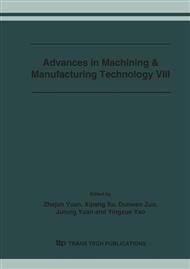p.597
p.602
p.607
p.612
p.617
p.623
p.628
p.632
p.637
Optimization of Cutting Conditions in Ultra-Precision Turning Based on Mixed Genetic-Simulated Annealing Algorithm
Abstract:
In ultra-precision turning process, the predictive modeling of surface roughness and the optimization of cutting conditions are the key factors to improve the quality of products and raise the efficiency of equipments. In this paper, the application of genetic algorithm in identifying nonlinear surface roughness prediction model is discussed, and presents mixed genetic-simulated annealing algorithm approach to optimization of cutting conditions in ultra-precision turning. The experiment was carried out with diamond cutting tools, for machining single crystal aluminum optics covering a wide range of machining conditions. The results of fitting of prediction model and optimal cutting conditions using genetic algorithm (GA) are compared with least square method and traditional optimal method.
Info:
Periodical:
Pages:
617-622
Citation:
Online since:
July 2006
Authors:
Keywords:
Price:
Сopyright:
© 2006 Trans Tech Publications Ltd. All Rights Reserved
Share:
Citation:


